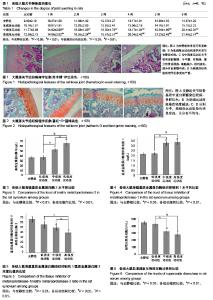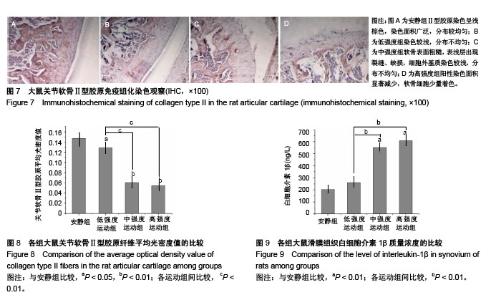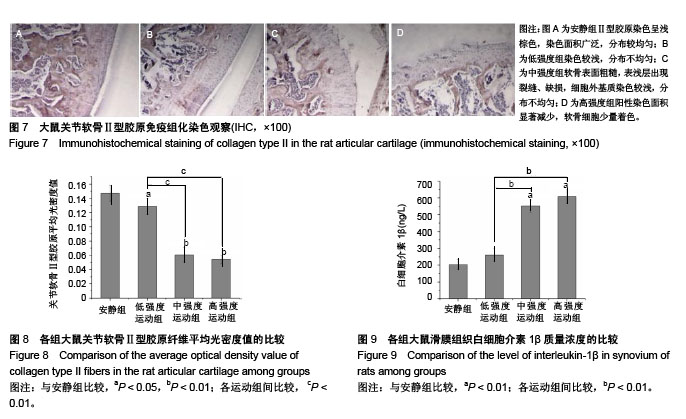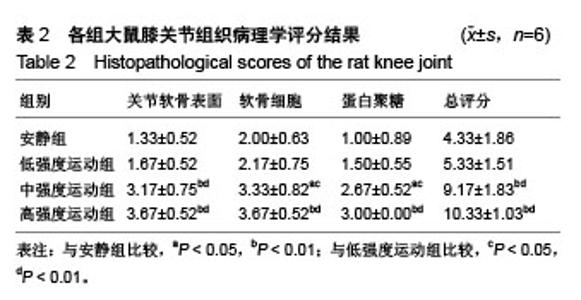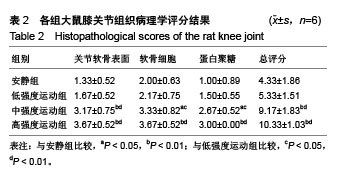Chinese Journal of Tissue Engineering Research ›› 2018, Vol. 22 ›› Issue (24): 3849-3856.doi: 10.3969/j.issn.2095-4344.0821
Previous Articles Next Articles
Establishment of a rat model of chronic osteoarthritis by intra-articular injection combined with treadmill exercise
Chen Shi-jie1, 2, Zhu Yang-xiong1, 2, Lao Wen-yan1, 2, 3, Zhou Yan-li1, 2, Zhao Xiao-hong1, 2, 3
- 1College of Biochemical Engineering, 2Institute for Science and Technology of Functional Food, 3Beijing Key Laboratory of Bioactive Substances and Functional Foods, Beijing Union University, Beijing 100191, China
-
Received:2017-11-01 -
Contact:Zhao Xiao-hong, Ph.D., Researcher, College of Biochemical Engineering, Beijing Union University, Beijing 100191, China -
About author:Chen Shi-jie, Master, College of Biochemical Engineering, Beijing Union University, Beijing 100191, China; Institute for Science and Technology of Functional Food, Beijing Union University, Beijing 100191, China -
Supported by:the Open Project of Beijing Key Laboratory of Bioactive Substances and Functional Foods of Beijing Union University, No. Zk70201501
CLC Number:
Cite this article
Chen Shi-jie1, 2, Zhu Yang-xiong1, 2, Lao Wen-yan1, 2, 3, Zhou Yan-li1, 2, Zhao Xiao-hong1, 2, 3. Establishment of a rat model of chronic osteoarthritis by intra-articular injection combined with treadmill exercise[J]. Chinese Journal of Tissue Engineering Research, 2018, 22(24): 3849-3856.
share this article
| [1] Mccoy AM.Animal Models of Osteoarthritis: Comparisons and Key Considerations. Vet Pathol. 2015;52(5):803-818.[2] Wang T,Wen C,Lu W,et al.A study on the role of subchondral bone change in very early stage of osteoarthritis with Dunkin-Hartley guinea pigs.Beijing:International Congress of Chinese Orthopaedic Association Coa, 2011.[3] Pun YL,Moskowitz RW,Lie S,et al.Clinical correlations of osteoarthritis associated with a single-base mutation (arginine519 to cysteine) in type II procollagen gene. A newly defined pathogenesis.Arthritis Rheum.1994;37(2):264-269.[4] Young MF, Bi Y, Ameye L, et al. Biglycan knockout mice: new models f or musculoskeletal diseases. Glycoconj J.2002;19(4-5): 257-262.[5] Kalliopi LA,Pavlos L,Karadimas EV,et al.Useful animal models for the research of osteoarthritis. Eur J Orthop Surg Traumatol. 2014; 24(3):263-271.[6] Vincent TL,Williams RO,Rose M,et al.Mapping pathogenesis of arthritis through small animal models. Rheumatology.2012;51(11): 1931-1941.[7] Peters ST, Wilke M, Schmid T.Arthroscopic approach and anatomy of the stifle joint in the rabbit.Vet Surg. 2018;47(1): 130-135.[8] Knights CB,Gentry C,Bevan S.Partial medial meniscectomy produces osteoarthritis pain-related behaviour in female C57BL/6 mice. Pain.2012;153(2):281-292.[9] Khorasani MS, Diko S,Hsia AW, et al. Effect of alendronate on post-traumatic osteoarthritis induced by anterior cruciate ligament rupture in mice. Arthritis Res Ther. 2015;17:30.[10] Marijnissen AC,Van Roermund PM,TeKoppele JM, et al.The canine 'groove' model, compared with the ACLT model of Osteoarthritis.Osteoarthritis Cartilage.2002;10(2):145-155.[11] Palmoski MJ, Colyer RA, Brandt KD.Marked suppression by salicylate of the augmented proteoglycan synthesis in osteoarthritic cartilage. Arthritis Rheum. 1980;23(1):83-91.[12] 戴七一,覃学流,袁经阳,等.兔骨内高压型膝关节骨性关节炎模型的建立[J].中国组织工程研究与临床复, 2011, 15(20): 3645-3648.[13] Pernille HA,Laszlo BT,Thomas LA,et al.Ovariectomized rats as a model of postmenopausal osteoarthritis: validation and application. Arthritis Res Ther.2004;6:169-180.[14] Ando A,Suda H,Hagiwara Y,et al.Reversibility of Immobilization-Induced Articular Cartilage Degeneration after Remobilization in Rat Knee Joints. Tohoku J Exp Med. 2011; 224(2):77-85.[15] Burnham LJ, Dickenson AH. The antinociceptive effect of milnacipran in the monosodium iodoacetate model of osteoarthritis pain and its relation to changes in descending inhibition.J Pharmacol Exp Ther.2013;344(3):696-707. [16] Louer CR,Furman BD,Huebner JL,et al.Diet-induced obesity significantly increases the severity of posttraumatic arthritis in mice. Arthritis Rheum. 2012;64(10):3220-3230.[17] Beckett J, Wu J, Schultz M, et al.Excessive running induces cartilage degeneration in knee joints and alters gait of rats. J Orthop Res. 2012;30(10):1604-1610.[18] Aigner T, Cook JL, Gerwin N,et al. Histopathology atlas of animal model systems-overview of guiding principles. Osteoarthritis Cartilage.2010;18 Suppl 3(18 Suppl 3):S2.[19] Yun JL,Ji AP,Yang SH,et al.Evaluation of osteoarthritis induced by treadmill-running exercise using the modified Mankin and the new OARSI assessment system.Rheumatol Int. 2011;31(12): 1571-1576.[20] Stock M,Menges S,Eitzinger N,et al.A dual role for UCMA in osteoarthritis-Inhibition of aggrecanases and promotion of bone turnover. Arthritis Rheumatol.2017;69(6):1233-1245.[21] Chan DD,Xiao WF,Li J,et al.Deficiency of hyaluronan synthase 1 (Has1) results in chronic joint inflammation and widespread intra-articular fibrosis in a murine model of knee joint cartilage damage. Osteoarthritis Cartilage. 2015;23(11):1879-1889.[22] Joo H,Lee HJ,Shin EA, et al. c-Jun N-terminal Kinase-Dependent Endoplasmic Reticulum Stress Pathway is Critically Involved in Arjunic Acid Induced Apoptosis in Non-Small Cell Lung Cancer Cells. Phytother Res. 2016;30(4):596-603.[23] Takahashi K, Hashimoto S, Kurosaki H, et al. A pilot study comparing the efficacy of radiofrequency and microwave diathermy in combination with intra-articular injection of hyaluronic acid in knee osteoarthritis. J Phys Ther Sci. 2016;28(2):525-529.[24] Ni GX,Zhan LQ,Gao MQ,et al.Matrix metalloproteinase-3 inhibitor retards treadmill running-induced cartilage degradation in rats. Arthritis Res Ther. 2011;13(6):R192.[25] Lohmander LS, Brandt K D, Mazzuca S A, et al. Use of the plasma stromelysin (matrix metalloproteinase 3) concentration to predict joint space narrowing in knee osteoarthritis.Arthritis Rheum. 2005;52(10):3160-3167.[26] Tchetverikov I, Lohmander LS, Verzijl N, et al. MMP protein and activity levels in synovial fluid from patients with joint injury, inflammatory arthritis, and osteoarthritis. Ann Rheum Dis.2005; 64(5):694-698.[27] Sieghart D,Liszt M,Wanivenhaus A,et al.Hydrogen sulphide decreases IL-1β induced activation of fibroblast‐like synoviocytes from patients with osteoarthritis.J Cell Mol Med. 2015;19(1):187-197.[28] Rasheed Z,Al-Shobaili HA, Rasheed N,et al.Integrated Study of Globally Expressed microRNAs in IL-1β-stimulated Human Osteoarthritis Chondrocytes and Osteoarthritis Relevant Genes: A Microarray and Bioinformatics Analysis.Nucleosides Nucleotides Nucleic Acids. 2016;35(7):335-355.[29] Martin JA, Martini A, Molinari A, et al. Mitochondrial electron transport and glycolysis are coupled in articular cartilage. Osteoarthritis Cartilage. 2012;20(4):323-329.[30] Henrotin Y, Kurz B. Antioxidant to treat osteoarthritis: dream or reality?. Current Drug Targets. 2007;8(2):347-357.[31] 陈世杰,劳文艳,周艳丽,等.氨基葡萄糖、骨碎补和虾青素对大鼠急性骨关节炎的干预研究[J].食品工业科技, 2017,38(4):365-370。[32] 李会贤,朱顺英,戚亦萍,等.一种制作大鼠膝关节和椎间盘石蜡组织切片的方法[J].中国细胞生物学学报, 2009,31(1):125-129.[33] Tuncay IC, Özdemir BH, Demirörs H,et al.Pedunculated Synovium Grafts in Articular Cartilage Defects in Rabbits. J Invest Surg. 2005;18(3):115-122.[34] Mankin HJ,Dorfman H,Lippiello L,et al.Biochemical and Metabolic Abnormalities in Articular Cartilage from Osteo-Arthritic Human Hips. J Bone Joint Surg Am. 1971;53(3):523-537.[35] Kraus VB,Huebner JL,Degroot J,et al.The OARSI histopathology initiative - recommendations for histological assessments of osteoarthritis in the guinea pig. Osteoarthritis Cartilage. 2010; (Suppl 3):S35-52.[36] Aigner T,Cook JL, Gerwin N, et al. Histopathology atlas of animal model systems - overview of guiding principles. Osteoarthritis Cartilage. 2010;(18 Suppl 3):S2-6.[37] Gong D,Chu W,Jiang L,et al.Effect of fucoxanthin alone and in combination with D-glucosamine hydrochloride on carrageenan/kaolin-induced experimental arthritis in rats. Phytotherapy Research Ptr.2014;28(7):1054.[38] Hagiwara Y,Ando A,Chimoto E,et al.Changes of articular cartilage after immobilization in a rat knee contracture model. J Orthop Res. 2009;27(2):236-242.[39] Chang Q,Huang C,Huang Z.Matrix Metalloproteinases and Inhibitor in Knee Synovial Fluid as Cartilage Biomarkers in Rabbits: The Effect of High-Intensity Jumping Exercise. J Surg Res. 2007;140(1):149-157.[40] de Souza RA,Xavier M,Mangueira NM,et al.Raman spectroscopy detection of molecular changes associated with two experimental models of osteoarthritis in rats. Lasers Med Sci. 2014;29(2): 797-804.[41] Lee YJ, Park JA,Yang SH,et al.Evaluation of osteoarthritis induced by treadmill-running exercise using the modified Mankin and the new OARSI assessment system. Rheumatol Int. 2011; 31(12):1571-1576.[42] Naito K,Watari T,Furuhata A,et al.Evaluation of the effect of glucosamine on an experimental rat osteoarthritis model. Life Sciences.2010;86(13-14):538-543.[43] 詹荔琼,党娜,高美钦,等.大鼠膝关节软骨与不同强度跑台运动的影响[J].中国组织工程研究, 2012, 16(20): 3634-3638.[44] 邢丹,马信龙,徐卫国,等.不同强度跑台运动对大鼠膝关节软骨MMP-3、COL-Ⅱ、TIMP-3表达影响的研究[C]//浙江省中西医结合骨伤科专业委员会学术年会. 2013.[45] Joos H,Hogrefe C,Rieger L,et al. Single impact trauma in human early-stage osteoarthritic cartilage: implication of prostaglandin D2 but no additive effect of IL-1β on cell survival. Int J Mol Med. 2011;28(2):271-277.[46] Hulejová H,Baresová V,Klézl Z,et al.Increased level of cytokines and matrix metalloproteinases in osteoarthritic subchondral bone. Cytokine.2007;38(3):15. |
| [1] | Zhang Tongtong, Wang Zhonghua, Wen Jie, Song Yuxin, Liu Lin. Application of three-dimensional printing model in surgical resection and reconstruction of cervical tumor [J]. Chinese Journal of Tissue Engineering Research, 2021, 25(9): 1335-1339. |
| [2] | Peng Zhihao, Feng Zongquan, Zou Yonggen, Niu Guoqing, Wu Feng. Relationship of lower limb force line and the progression of lateral compartment arthritis after unicompartmental knee arthroplasty with mobile bearing [J]. Chinese Journal of Tissue Engineering Research, 2021, 25(9): 1368-1374. |
| [3] | Huang Dengcheng, Wang Zhike, Cao Xuewei. Comparison of the short-term efficacy of extracorporeal shock wave therapy for middle-aged and elderly knee osteoarthritis: a meta-analysis [J]. Chinese Journal of Tissue Engineering Research, 2021, 25(9): 1471-1476. |
| [4] | Liu Xiangxiang, Huang Yunmei, Chen Wenlie, Lin Ruhui, Lu Xiaodong, Li Zuanfang, Xu Yaye, Huang Meiya, Li Xihai. Ultrastructural changes of the white zone cells of the meniscus in a rat model of early osteoarthritis [J]. Chinese Journal of Tissue Engineering Research, 2021, 25(8): 1237-1242. |
| [5] | Zeng Yanhua, Hao Yanlei. In vitro culture and purification of Schwann cells: a systematic review [J]. Chinese Journal of Tissue Engineering Research, 2021, 25(7): 1135-1141. |
| [6] | Liu Xin, Yan Feihua, Hong Kunhao. Delaying cartilage degeneration by regulating the expression of aquaporins in rats with knee osteoarthritis [J]. Chinese Journal of Tissue Engineering Research, 2021, 25(5): 668-673. |
| [7] | Ma Zetao, Zeng Hui, Wang Deli, Weng Jian, Feng Song. MicroRNA-138-5p regulates chondrocyte proliferation and autophagy [J]. Chinese Journal of Tissue Engineering Research, 2021, 25(5): 674-678. |
| [8] | Cao Xuhan, Bai Zixing, Sun Chengyi, Yang Yanjun, Sun Weidong. Mechanism of “Ruxiang-Moyao” herbal pair in the treatment of knee osteoarthritis based on network pharmacology [J]. Chinese Journal of Tissue Engineering Research, 2021, 25(5): 746-753. |
| [9] | Li Yonghua, Feng Qiang, Tan Renting, Huang Shifu, Qiu Jinlong, Yin Heng. Molecular mechanism of Eucommia ulmoides active ingredients treating synovitis of knee osteoarthritis: an analysis based on network pharmacology [J]. Chinese Journal of Tissue Engineering Research, 2021, 25(5): 765-771. |
| [10] | Song Shan, Hu Fangyuan, Qiao Jun, Wang Jia, Zhang Shengxiao, Li Xiaofeng. An insight into biomarkers of osteoarthritis synovium based on bioinformatics [J]. Chinese Journal of Tissue Engineering Research, 2021, 25(5): 785-790. |
| [11] | Deng Zhenhan, Huang Yong, Xiao Lulu, Chen Yulin, Zhu Weimin, Lu Wei, Wang Daping. Role and application of bone morphogenetic proteins in articular cartilage regeneration [J]. Chinese Journal of Tissue Engineering Research, 2021, 25(5): 798-806. |
| [12] | Xu Dongzi, Zhang Ting, Ouyang Zhaolian. The global competitive situation of cardiac tissue engineering based on patent analysis [J]. Chinese Journal of Tissue Engineering Research, 2021, 25(5): 807-812. |
| [13] | Wu Zijian, Hu Zhaoduan, Xie Youqiong, Wang Feng, Li Jia, Li Bocun, Cai Guowei, Peng Rui. Three-dimensional printing technology and bone tissue engineering research: literature metrology and visual analysis of research hotspots [J]. Chinese Journal of Tissue Engineering Research, 2021, 25(4): 564-569. |
| [14] | Chang Wenliao, Zhao Jie, Sun Xiaoliang, Wang Kun, Wu Guofeng, Zhou Jian, Li Shuxiang, Sun Han. Material selection, theoretical design and biomimetic function of artificial periosteum [J]. Chinese Journal of Tissue Engineering Research, 2021, 25(4): 600-606. |
| [15] | Liu Fei, Cui Yutao, Liu He. Advantages and problems of local antibiotic delivery system in the treatment of osteomyelitis [J]. Chinese Journal of Tissue Engineering Research, 2021, 25(4): 614-620. |
| Viewed | ||||||
|
Full text |
|
|||||
|
Abstract |
|
|||||
